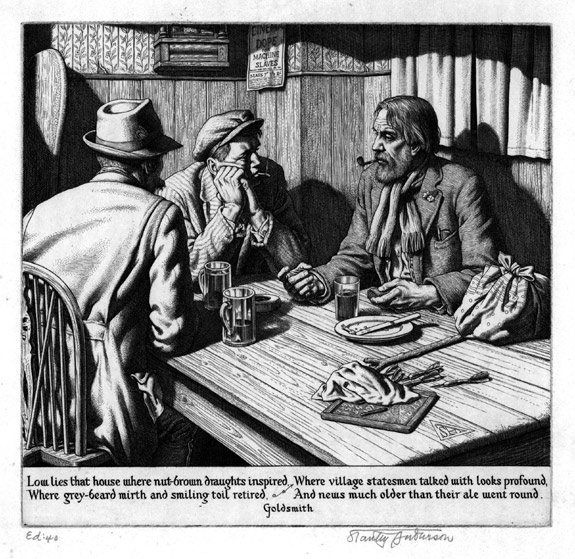|
STANLEY ANDERSON R.A., R.E.
(Bristol 1884 – 1966 Towersey)
The Wayfarer

The Wayfarer
Ref: Meyrick 232
164 x 172 mm
Original engraving, 1941.
Edition of 40.
The plate signed with his monogram
(in the manner of old master engravings).
£850
The quotation from Oliver Goldsmith’s poem The Deserted Village commemorates
the traditional ways of living, disappearing in the modern world of industrialisation
and commerce.
To view a higher resolution version of this print, please click this link: The Wayfarer
|
|
Additional
Information about the Print
The son of a heraldic engraver, Anderson completed a seven year apprenticeship
in Bristol as a metal engraver before winning a scholarship to the Royal College
of Art in London in 1909.
His early plates were all etched, before he turned to drypoint in the 1920’s;
his subjects - topographical architecture and figure subjects with a sympathetic eye
for humour in the human condition.
From the 1930’s Anderson worked exclusively in line engraving to create his celebrated
meticulously detailed studies of rural craftsmen and disappearing ‘occupations’ in
Oxfordshire.
By the 19th century copper line engraving had come to be associated with prints
which reproduced paintings by other artists, while etching was the preferred intaglio
technique for artists making original prints themselves.
But in the mid-1920’s a number of artists revived an interest in line engraving, inspired
by the Old Masters, such as Dürer*, who had themselves used engraving to make original prints.
The artist uses a burin to incise the lines of his design straight into the copper.
Any shaving of metal raised in this process is removed so that a clean sharp line, tapering
at its extremity to a point, is created.
Engravings are printed on the same intaglio roller press as etchings. For printing, the plate is
inked up and wiped, removing most of the ink from the surface and forcing it into the
lines of the design engraved into the plate.
The rollers of the press exert great pressure
pressing the dampened paper into the grooves to collect the ink.
Old master artists such as Dürer* often signed their plates with their initials as a monogram
and British 20th century artists, as Anderson here, imitated this for their own engravings,
though they would sign their etched plates, if at all, with their name in full.
Signing prints in pencil, and limiting editions, is a ‘modern’ concept, begun only in the later
19th century.
* See Dürer’s line engraving The little Fortune by following this link: Durer, The Little Fortune.
For more information, and further examples of engravings and Intaglio forms of printmaking, please explore the Engraving page in the Techniques section of this website. |